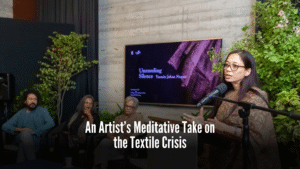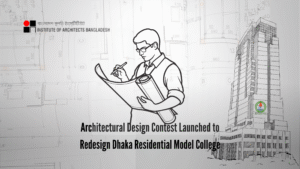Day: October 15, 2025

An Artist’s Meditative Take on the Textile Crisis
On 10th October, Bengal Shilpalay’s Quamrul Hassan Hall made room for Yasmin Jahan Nupur’s solo exhibition to breathe in silence. Silence that carries the weight of unspoken resistance, forged over decades. Each corner is equipped with different kinds of soft sculptures and artworks, woven and drawn with bare hands. These sculptures will urge you to zoom in, squint, and at times, resist touching and feeling their texture. The space is surrounded by a variety of installations, including tapestry, jamdani woven in a grid-like matrix, a golden net made of zari threads, Bangla phrases stitched in muslin fabric, and hand-drawn textures and patterns. The sculptures, made from gentle materials like thread and wool, celebrate their natural malleability and softness. Her meticulously executed works on paper using only pen and watercolor draw viewers into their quiet depths. In contrast, Nupur’s brass sculptures defy expectation, transforming rigid metal into forms that appear almost supple. As one takes a closer look, they can find the artist’s sheer brilliance of witty and powerful juxtaposition of delicate threads and robust objects. One of the guests at the opening, globally famous architect Marina Tabassum, who won Aga Khan Award twice, reflected on the powerful presence of silence—describing it as an equally vital element in architecture, a space everyone strives to reach, yet few truly achieve in the process of creation. She observed that Nupur’s works embody that very quality, carrying a quiet strength despite being crafted from simple materials like strand and wool. The softness of Nupur’s sculptures and the intricacies of her work, in fact, carry a more concrete and unsettling truth—illuminating the fading textile legacy of Bengal. Behind these delicate forms lie the stories of countless artisans unable to continue their craft, disrupted not only by economic pressures but also by colonial legacies and ecological changes. A powerful installation in the exhibition was a dazzling hanging burqa. While the traditional burqa symbolizes modesty and concealment, Nupur reimagined it as a three-dimensional form embroidered with gold and silver zari threads—not as a symbol of elegance, but as a testament to distressed endurance. Nupur’s professor, Abul Monsur, recalls how her gentle demeanor during her time at the Fine Arts Institute, CU, fooled him into perceiving her as rather fragile. Her quiet resilience and unwavering devotion to her craft beneath that delicate surface only proved him wrong over time. Yasmin Jahan Nupur not only hails a heavy portfolio of glorious works but also became a household name in the international galleries. This second solo exhibition is Nupur’s careful documentation and a commitment to preserving the vanishing heritage of Bangladesh’s textiles. As visitors walk through the gallery, they are compelled to stop, gaze, and ultimately begin to unravel the silences behind each piece. “Even though the voice may be muted or just a soft whisper (mridu shor), the visitors must take the time to truly listen,” quotes curator Tanzim Wahab. “Unravelling Silence” is on view until November 22, every day from 4 to 8 PM, except Sundays, at Bengal Shilpalay. Written by- Fariha Hossain
Read More
Architectural Design Contest Launched to Redesign Dhaka Residential Model College
A nationwide architectural design competition has been launched to transform the campus of Dhaka Residential Model College (DRMC), one of Bangladesh’s most prestigious educational institutions. The initiative, jointly organised by the Institute of Architects Bangladesh (IAB) and DRMC, calls for proposals to design a ten-storied academic building that will serve as a modern educational hub for over 3,000 students. The competition aims to address long-standing infrastructural challenges at DRMC, which currently operates in two shifts due to a shortage of classroom space. With most of its buildings dating back to the 1960s, the college’s facilities are no longer adequate to meet the demands of its growing student body and evolving academic programs. A Legacy in Transition Established in 1960, DRMC spans 52 acres in Mohammadpur and accommodates approximately 6,000 students across various academic levels. Initially governed by the Central Government of Pakistan, the institution underwent several administrative transitions before being placed under the Ministry of Education in 1972. Despite its autonomous status and historical significance, the college’s infrastructure has aged considerably, prompting the Board of Governors (BOG) to approve a major upgrade during its 162nd meeting on June 26, 2025. The new academic building will be constructed on a 3,000 sq.m site currently occupied by a grassy football field. According to the competition brief, the structure will be a reinforced concrete (RCC) building with pile foundation, designed to accommodate students from classes 9 to 12. Facilities will include a cafeteria, exam halls with 800 seats, modern toilets, and parking provisions. Competition Details and Design Vision The competition, launched on October 5, 2025, is a single-stage open call for Bangladeshi architects. It seeks innovative, sustainable, and contextually responsive designs that integrate seamlessly with the existing campus. Architects are encouraged to use local materials and environmentally friendly technologies, with an emphasis on rapid construction techniques and low future maintenance costs. Design considerations outlined in the brief include: climate responsiveness and passive cooling, universal accessibility, integration of landscape and open spaces, cultural and contextual relevance, interconnectivity with existing academic buildings, energy efficiency and future-readiness The building’s shape may follow an I, U, hollow box, or full box configuration, with each floor serving distinct academic and administrative functions. The ground floor will house parking and essential services, while upper floors will include classrooms, laboratories, faculty offices, and student amenities. Organisers and Eligibility The competition is jointly organised by IAB and DRMC. Eligible participants must be regular IAB members with at least eight years of professional experience and compliance with the Dhaka Mohanagar Imarat Nirman Bidhimala, 2008. Registration, which requires a Tk 2,000 fee, is open from October 5 to October 11, 2025, at the IAB office in Sher-E-Bangla Nagar, Dhaka. Each participant will receive a unique registration code and may submit only one proposal. All submissions must maintain strict anonymity, with documents marked only by a blank square box and the registration number. Any breach of anonymity or direct contact with jury members will result in disqualification. The design competition is going to be launched on October 5,2025, inviting participants to register by October 12. A query session will open on October 13, and all inquiries will be addressed by October 15. Participants must submit by November 20. Jury Deliberation will take place in November 22 to December 9, followed by an exhibition scheduled for December 9 to December 10, 2025. Submissions must include conceptual sketches, detailed plans, elevations, sections, renderings, and a physical model. Reports on design concepts and estimated construction costs are required in sealed envelopes. Digital copies must be submitted via DVD or pen drive. The brief also requires labelling with the 14-digit registration number and a blank square box. The jury panel comprises five distinguished members: Brigadier General Mohammed Zaber Hossain, PhD – Principal, DRMC, Moshiur Rahman – Acting President, Old Remians Welfare Association, Ar Jalal Ahmed – Principal Architect, JAARCHITECTS, Ar Patrick D’ Rozario – Principal Architect, Synthesis Architects Limited, and Ar S.M. Nazimuddin Payel – Associate Professor, Architecture Discipline, Khulna University. The jury will evaluate entries based on innovation, contextual relevance, sustainability, and feasibility. Their decisions are final and binding, with results to be announced during the exhibition. Awards and Future Engagement The competition offers substantial monetary rewards and professional recognition: First Prize: Tk 2,50,000 and a certificate, Second Prize: Tk 1,75,000 and a certificate, Third Prize: Tk 1,00,000 and a certificate, Special Mentions (3): Tk 25,000 each and certificates, if awarded by the jury. The first-prize winner will be formally appointed as the design architect for the project, subject to compliance with IAB’s Code of Ethics and Professional Conduct. The appointment will follow Rule 111 of the Public Procurement Rules 2008, with consultancy fees set at 6% of the total construction cost (inclusive of AIT, exclusive of VAT). If the first-prize winner is disqualified, the second or third-place winners may be considered. A New Master Plan for DRMC The competition is part of a broader master plan revision for DRMC’s campus. The existing master plan, which did not account for new academic buildings, is being restructured to accommodate future growth and integration with existing facilities. Key components of the revised master plan include: vertical extension of Academic Building-3, extension and renovation of Kudrot-E-Khuda and Joynul Abedin Houses, construction of a duplex principal residence, a G+6 vice-principal residence, renovation of the boundary wall, upgradation of the water distribution system, and installation of a 500 KVA electric substation These developments aim to modernise the campus while preserving its legacy and enhancing operational efficiency. Legal and Ethical Framework Participants must adhere to the competition’s legal and regulatory principles. The organiser reserves the right to cancel the competition, in which case entries will be evaluated and prizes awarded. However, none of the submitted designs may be executed without the architect’s consent. In such cases, the first-prize winner will receive three times the prize money as compensation. DRMC will retain ownership of submitted documents until results are published. Entrants will retain copyright but grant DRMC a perpetual, royalty-free licence
Read More
